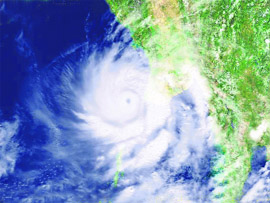|
In the name of the cyclone
Lalit Mohan

The recent cyclone which hit Myanmar was given the name Nargis |
Nargis is a
delicate and scented flower. It is the daffodil of Wordsworth’s
poetry — the narcissus of botany. But how did its name ever
get tagged on to a cyclone that killed possibly more than 50,000
people in Myanmar and caused huge attendant havoc?
Tropical storms
are given quaint monikers primarily to provide ease of
communication between forecasters and the general public. Since
cyclones or typhoons or hurricanes can often last a week or
longer, and more than one can occur in the same basin at the
same time, proper names can reduce the confusion about the storm
being described. It is an easier way of exchanging information
than identifying them numerically, or in terms of longitudes,
latitudes and wind speeds.
The first person
to use a proper name for a tropical cyclone was an Australian
forecaster, Clement Wragge, early in the 20th century. He gave
storms names after political figures whom he disliked. He could,
thus, publicly describe a politician as ‘causing great
distress’ or ‘wandering aimlessly about the Pacific’, and
take great pleasure in doing so.
The world was
subsequently divided into several zones for weather monitoring,
each with its own rules about christening storms. Normally, a
wind speed of 35 knots is the qualifying mark. Not all of them
cause widespread havoc, and are therefore not heard of, but are
still of concern to sailors and farmers.
During World War
II, tropical cyclones were informally given women’s names by
US military meteorologists who were monitoring and forecasting
storms over the Pacific, after their girlfriends or wives. From
1950 to 1952, hurricanes of the North Atlantic Ocean were
identified by the phonetic alphabet (Able-Baker-Charlie-etc.),
but in 1953 the US Weather Bureau changed to women’s names. In
1979, after protests by feminist groups, they switched to annual
lists that also included men’s names, and they alternate with
the women’s. Six lists, arranged in alphabetical order, are
used in rotation. Thus, the 2008 list will be used again in
2014.
In the US the
letters Q, U, X, Y, and Z are not included because of the
scarcity of names beginning with those letters. If more than 21
named tropical cyclones occur in a year, the Greek alphabet will
be used following the "W" name. In 2005, following
Wilma they had Alpha, Beta, Gamma, Delta, Epsilon
and Zeta.
If the tropical
storm or hurricane moves into a different basin it was renamed
to whatever name was next on the list for the area. In July,
1996, when Atlantic Basin Hurricane Cesar moved across Central
America, it was renamed North-East Pacific Basin Hurricane
Douglas.
Each region uses
monikers that are native to it. Fiji has listed names such as
Zita, Zaka, Zena, Zoc and Zazu. But they also have Gita, Meena
and Nisha, explained by the large presence of people of Indian
origin in the country.
Beginning January
1, 2000, tropical cyclones in the North-West Pacific Basin are
being given Asian names which are contributed by all the nations
and territories that are members of the WMO Typhoon Committee.
These newly selected names are, by and large, are not personal
in nature. The majority are of flowers, animals, birds, trees,
or even foods, while some are descriptive adjectives. Secondly,
the names are not used alphabetically, but in the order
stipulated by the contributing nation.
However, if any
hurricane or typhoon causes widespread damage, then its name is
‘retired’ forever from the list. No one likes unhappy
memories. Thus Katrina, which devastated southern USA, was
dropped in 2005. Marilyn, Rita and Roxanne are some of the
others that are now history. In all, 72 names have been ‘retired’
in the Atlantic basin. A retired name is replaced with a
like-gender name beginning with the same letter. For example,
Honduras recommended in 1998 that the name Mitch be ‘retired’
and proposed the replacement name, Matthew. No doubt, Nargis
will never be used again.
The Panel on
Tropical Cyclones for the Bay of Bengal and the Arabian Sea
implemented its own name list, and started to use it in
September, 2004. In the Indian Ocean rim, eight countries give
eight names each. The countries themselves are alphabetised,
starting with B for Bangladesh and ending at T for Thailand, but
the names they give are used sequentially. There are no annual
rolls. India chose Agni, Akash, Bijli, Jal, Lehar, Megh, Sagar
and Vayu. Nargis was in the Pakistan list, and its turn came up
when Myanmar was lashed by the storm currently in the news. Next
on the Indian Ocean list is Abe from Sri Lanka. The less we hear
of it, or of any cyclone, the better.

|